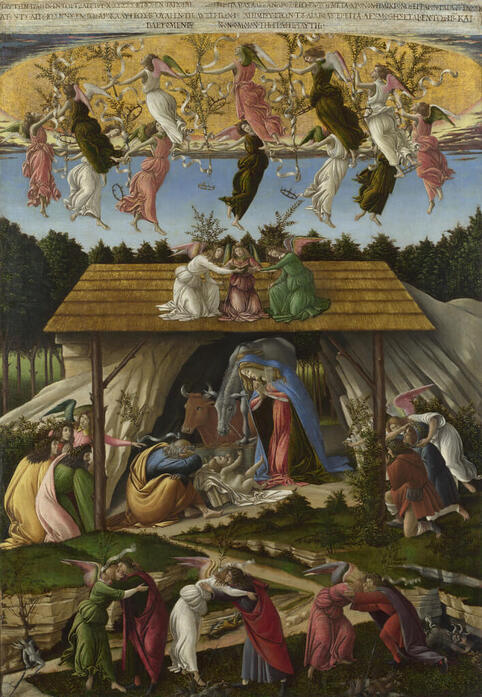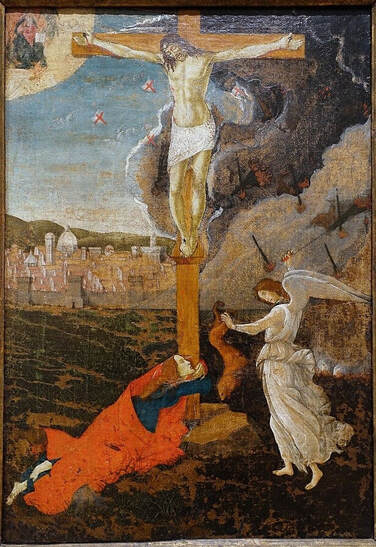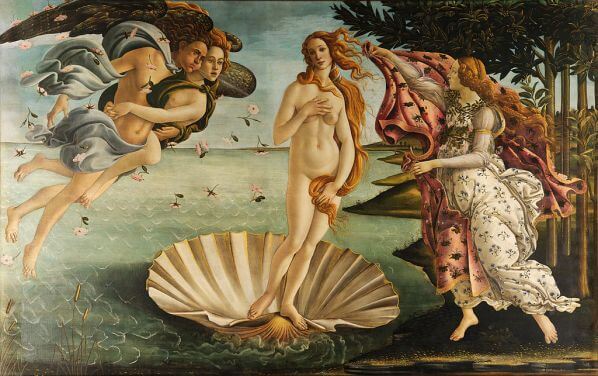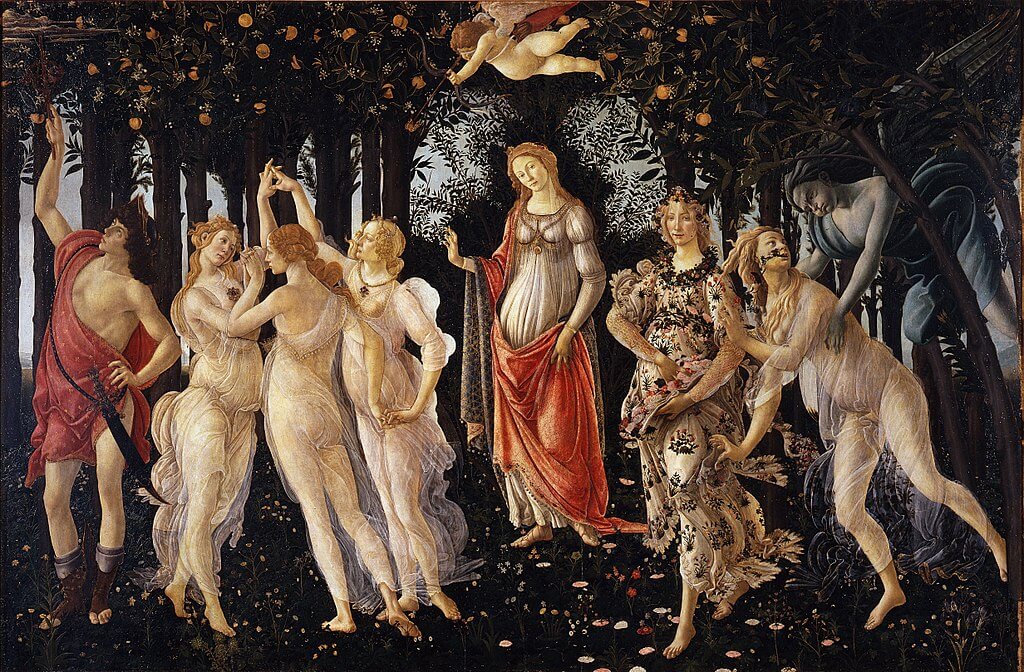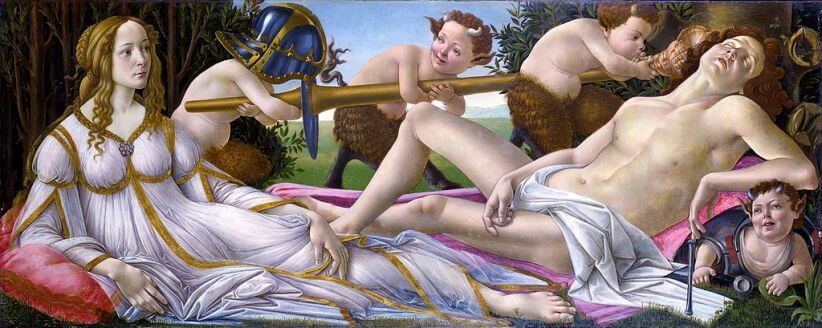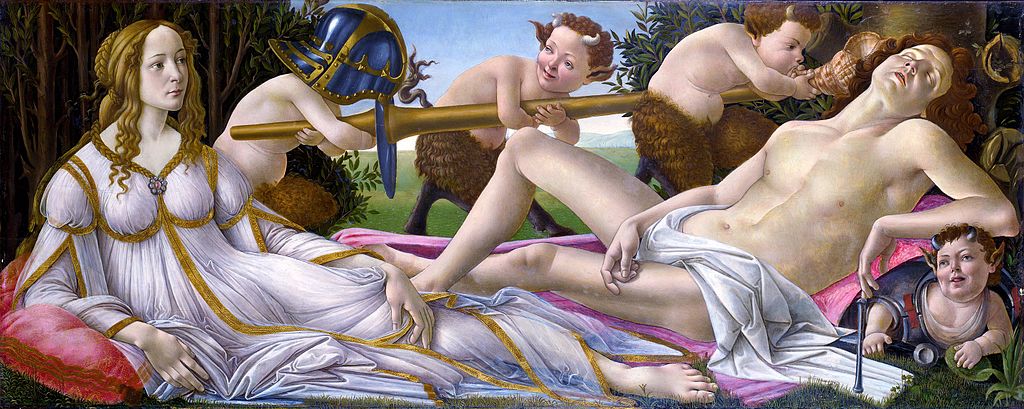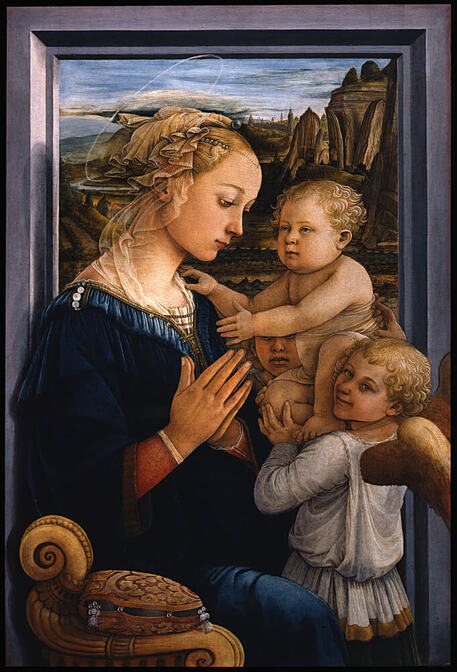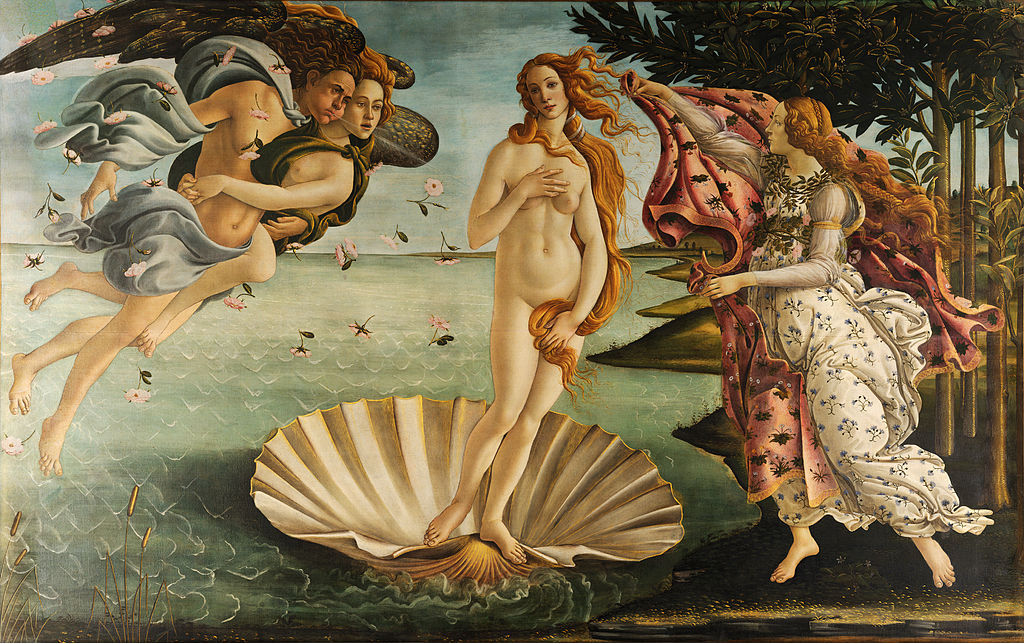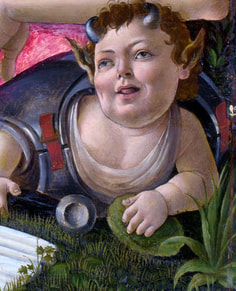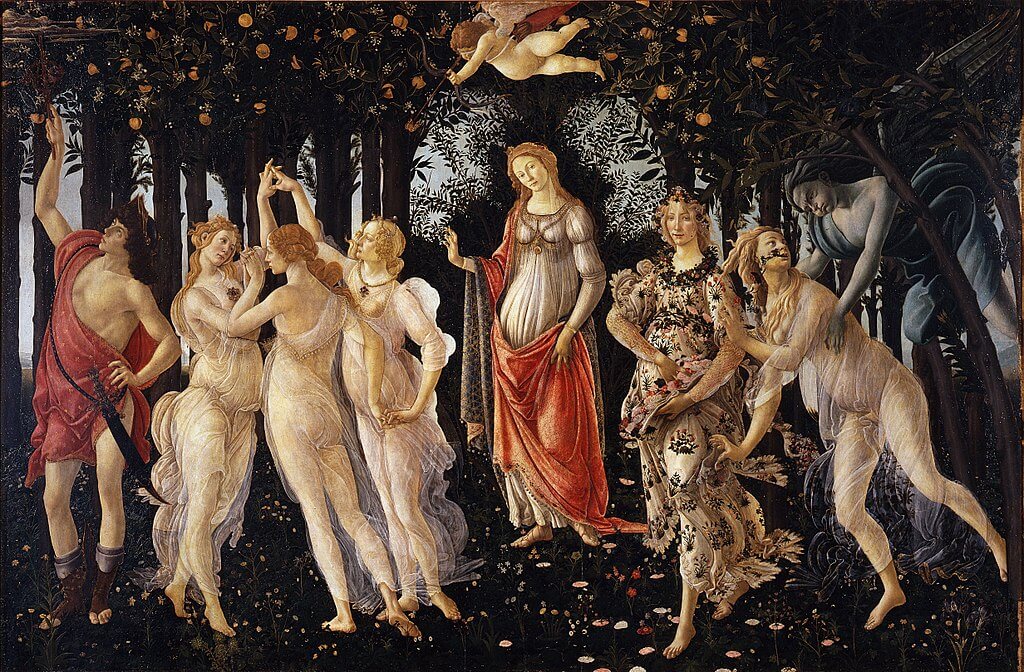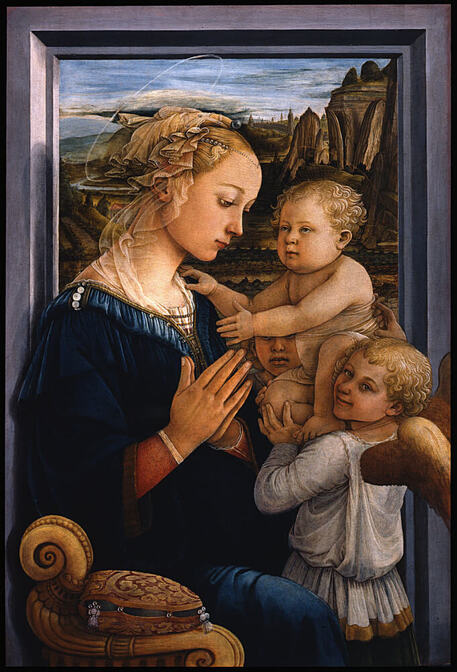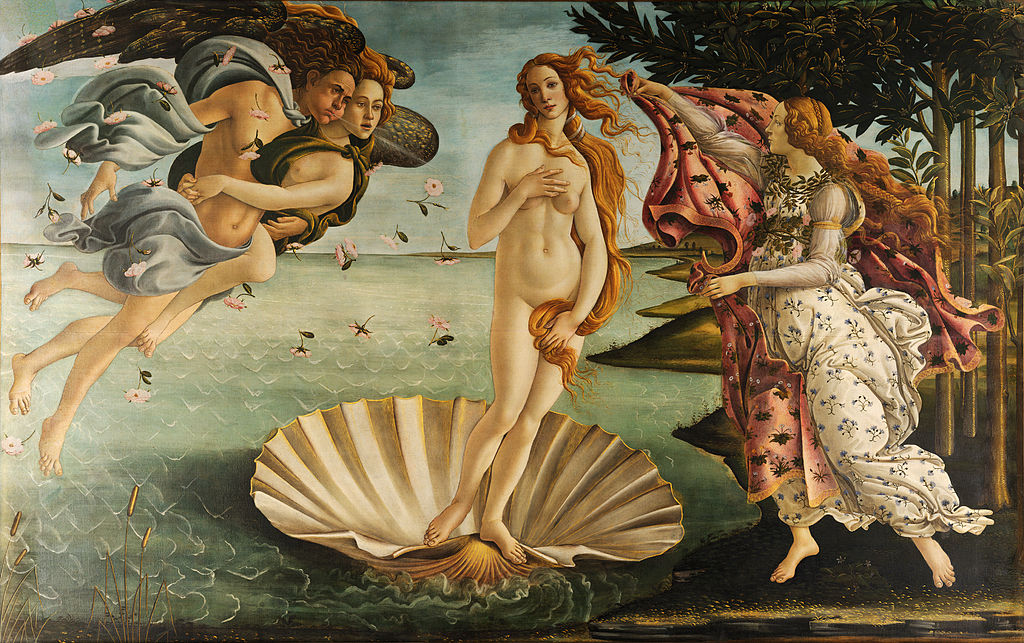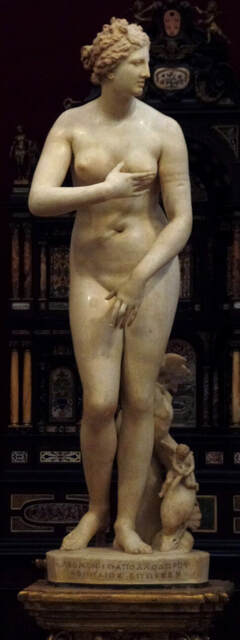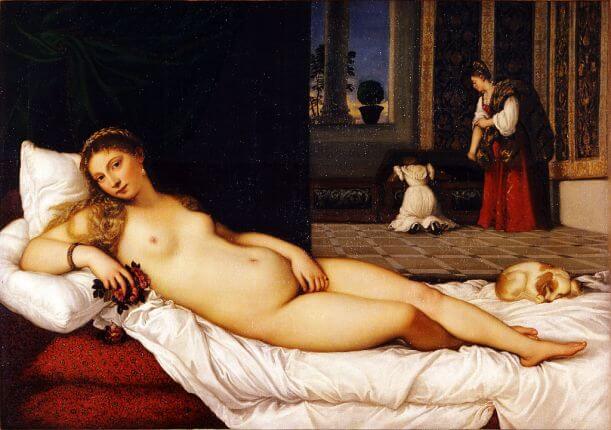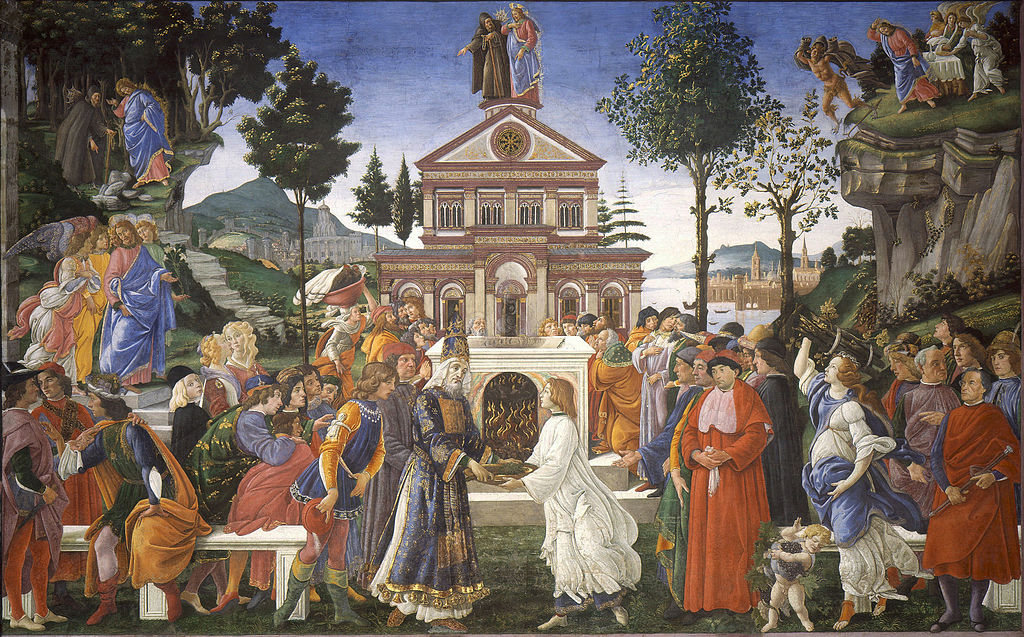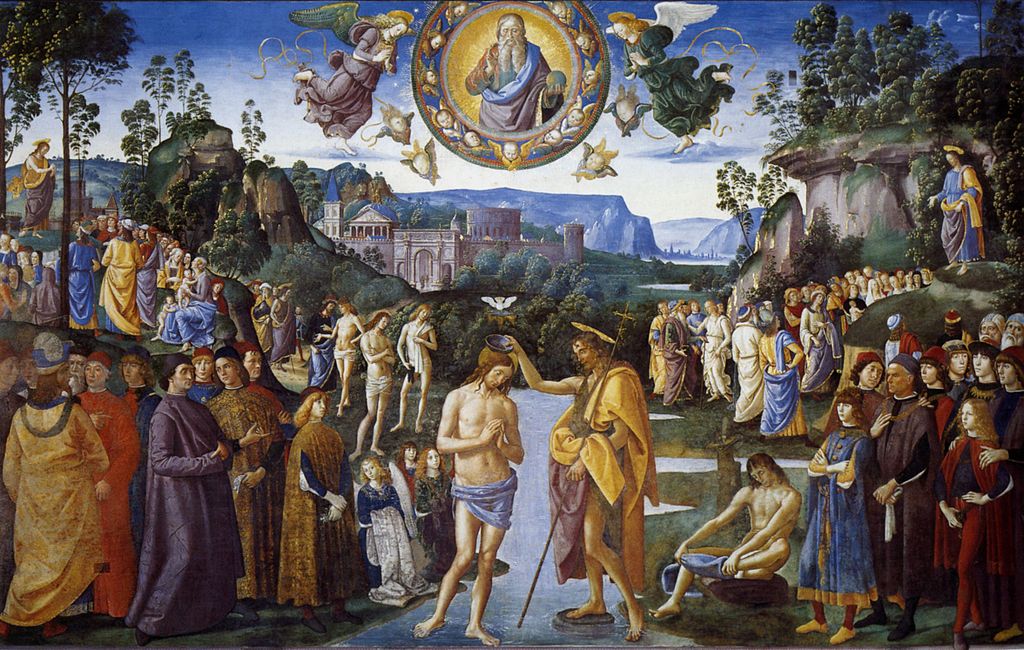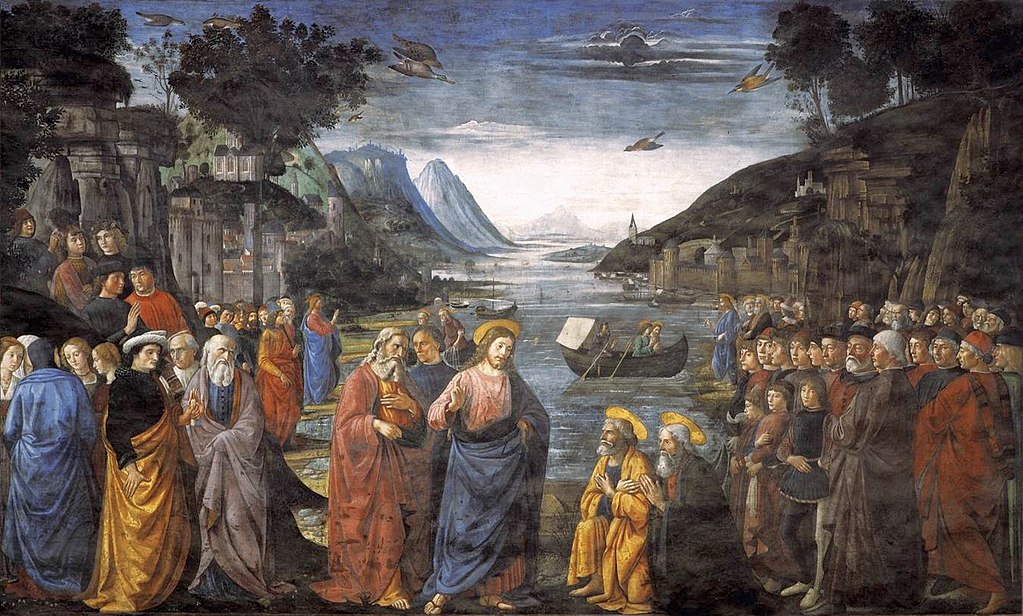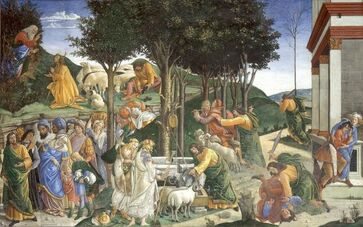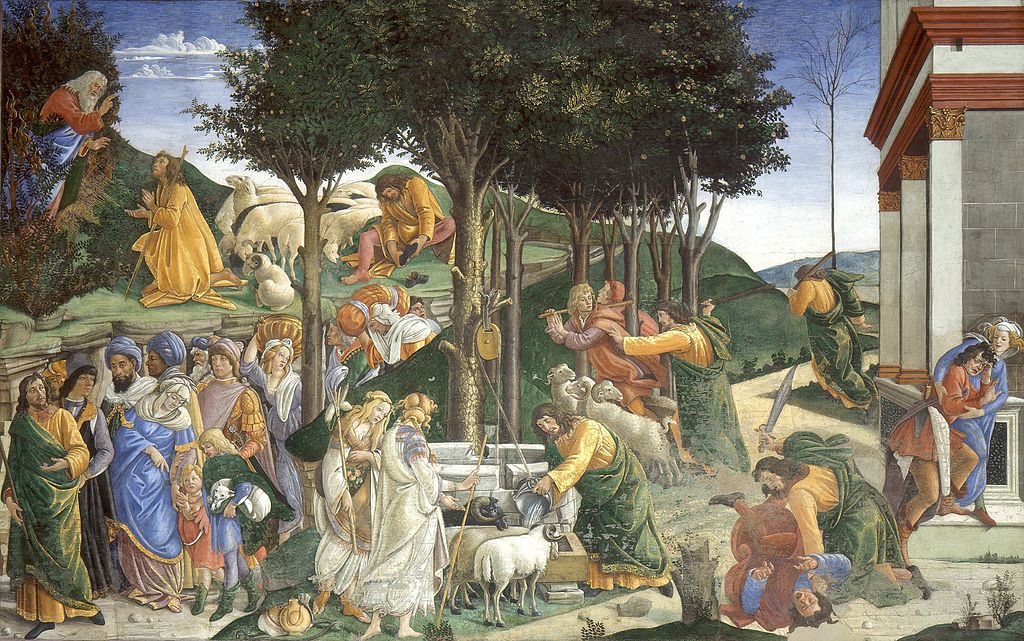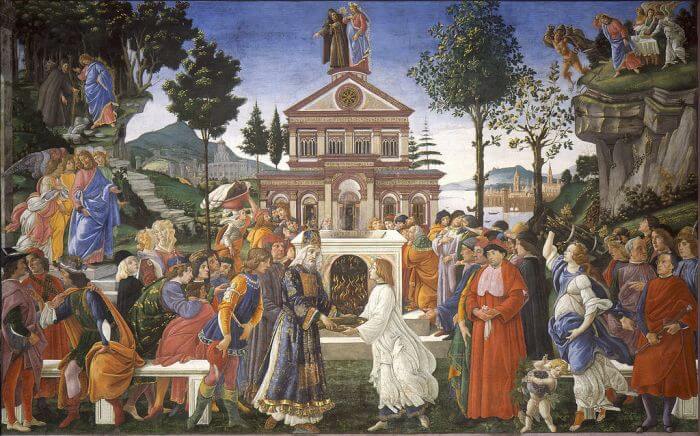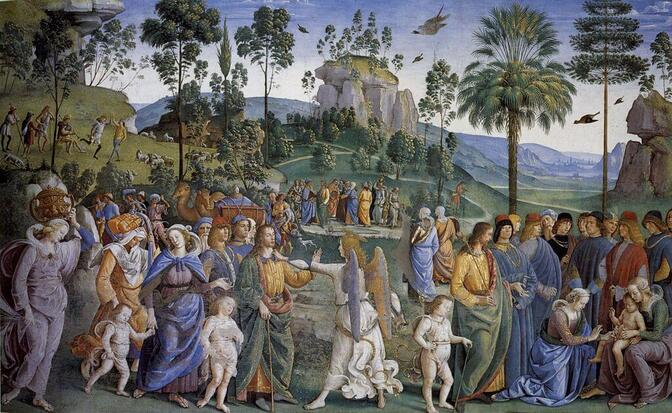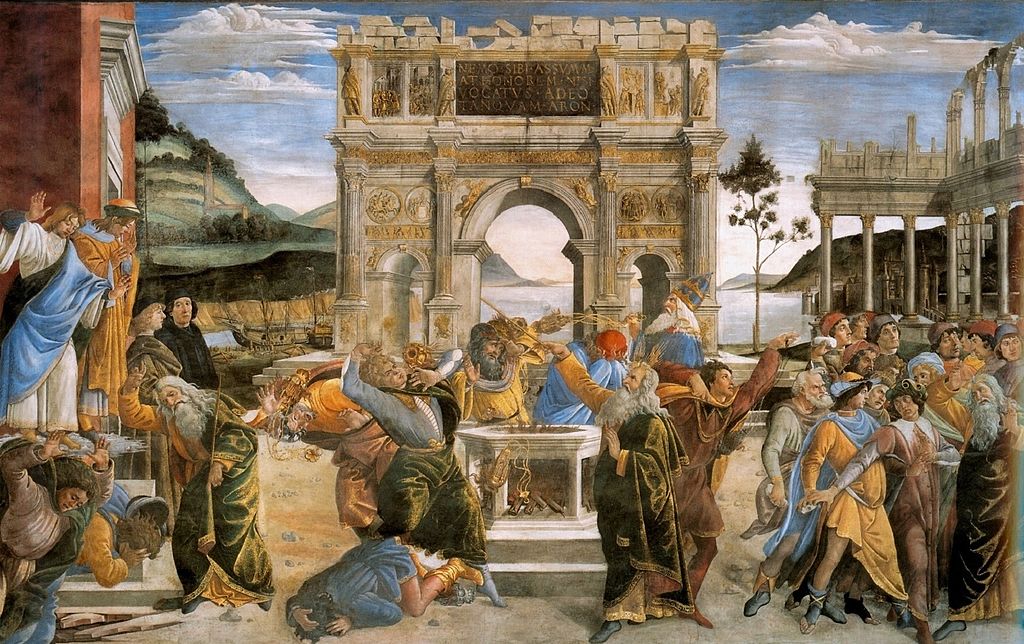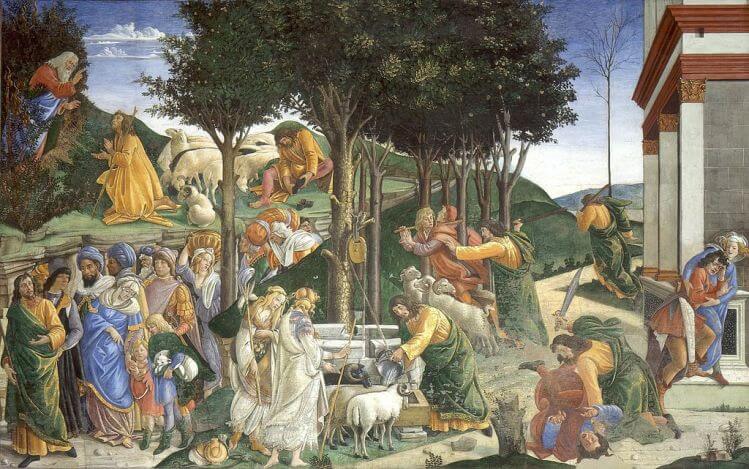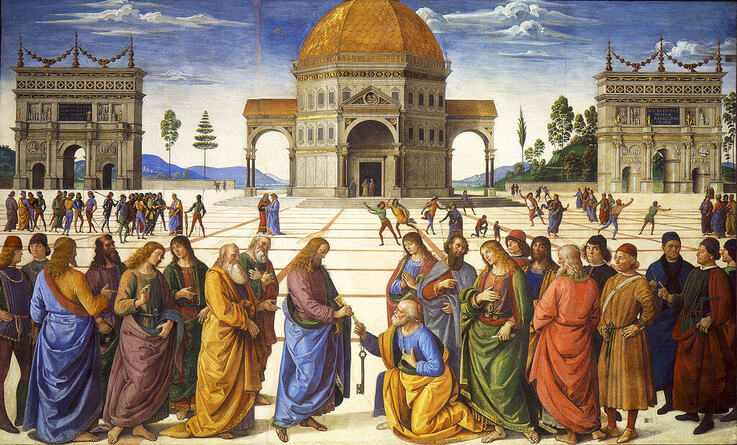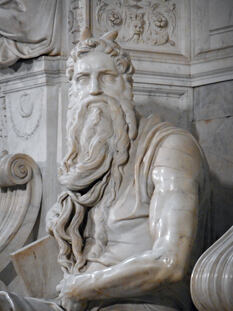|
Where? Room 57 of the National Gallery
When? 1500 Commissioned by? Botticelli probably made this picture for himself What do you see? In the center of this painting, you can see a naked baby Jesus. His mother, the Virgin Mary, is depicted to his right and is much larger than the other figures. His father, Saint Joseph, is on his left. Behind Jesus are a horse and an ox. Together they are staying in a stable. On top of the stable are three angels. One is reading a book, and the other two are holding an olive branch. To the left of Joseph is an angel in pink, holding an olive branch with a scroll attached to it, while reaching out to Joseph to introduce the three wise men. On the right of Mary is another angel with three shepherds who want to pay their respects to Jesus. In the foreground are three pairs consisting of one angel and one man embracing each other. Each pair holds an olive branch in their hand with a scroll attached to it. They are surrounded by several little imps or devils who are killing themselves with their spears. On top of the painting is a choir of 12 angels holding hands. The angels are doing a mystic ring dance. They are also holding an olive branch in their hands with a scroll attached to it and a crown hanging at the bottom of the branch. The angels are under the golden dome of heaven. Above this dome is a Greek inscription based on some parts of the Revelations of John related to the apocalypse. Backstory: This painting is also called ‘The Mystical Nativity’, and it is the only painting that Botticelli signed. This painting combines the story of the birth of Jesus with his return to earth according to the apocalypse. The title of this painting contains the word mystic because the parts of the painting referring to the apocalypse are prophetic and express a mystery. The word mystic is occasionally used to refer to exceptional paintings with mysterious and symbolic content. Another example of such a painting is the Mystic Crucifixion by Botticelli which is in the Fogg Art Museum in Boston.
Inscription: The inscription on top of the painting contains a message in Greek. It is translated as: “I Sandro painted this picture at the end of the year 1500 in the troubles in Italy in the half time after the time according to the 11th chapter of St. John in the second woe of the Apocalypse in the loosing of the devil for three and a half years. Then he will be chained in the 12th chapter and we shall see him trodden down as in this picture.” This message of Botticelli is based on the 11th and 12th chapter of the Revelations of John.
Botticelli believed that the apocalypse as described in the Bible was going to happen in 1504. Specifically, he believed that he was living in the Tribulation, a short period of time in which the world would suffer from hardship and disasters. He believed that the Millennium, a period of a thousand years during which Jesus would return to earth, would start in three and a half years. This belief of Botticelli was particularly based on the various wars going on at that time and the hanging, two years earlier, of the Florentine preacher Savonarola of whom Botticelli was a follower. Symbolism:
Who is Botticelli? Sandro Botticelli (1445-1510) was born as Alessandro di Mariano di Vanni Filipepi in Florence. Most of his paintings have a religious theme, but he also painted portraits and mythological scenes. The latter theme resulted in his most famous works, such as The Birth of Venus and La Primavera, both in the Uffizi Museum. His painting of Venus and Mars, which is also in the National Gallery, is also a masterpiece. In the 1490s, Botticelli got heavily influenced by the extremist preacher Savonarola, and he even stopped painting for a while to become a full member of Savonarola’s sect. However, he picked up painting again after a while, though his productivity was lower than before (though this is not entirely certain as almost all paintings of Botticelli are undated).
Fun fact: The Nativity scene in this painting is the story of the birth of Jesus as described in the gospels of Matthew and Luke. Mary was still a virgin, and God promised her that she would give birth to the Christ. The accounts of Matthew and Luke, however, differ quite a bit and both have their unique components.
According to Matthew, Jesus was visited by three wise men who followed a star to worship him. Luke describes that an angel announces the birth of Jesus to the shepherds and that they subsequently visit Jesus. Also, according to Luke, but not according to Matthew, the birth of Jesus happened in Bethlehem and Jesus was born in a stable. Botticelli combined elements from both gospels for this painting. Interested in a copy for yourself? Poster of canvas.
0 Comments
Where? Room 58 of the National Gallery
When? 1482-1485 What do you see? On the left, you see the goddess Venus who is carefully watching the god Mars on the right, who is asleep. Venus and Mars are having an adulterous affair. Uncharacteristically, Mars is unarmed, and he lies on a red cloak. You can also see four fauns (mythological figures who are half human and half goat, have small horns and tails, and they are followers of Bacchus). The fauns are blowing a Triton’s shell (a hunting horn in ancient times) like a trumpet in the ear of Mars to show that after making love even this very loud sound will not wake him up. They are also jokingly playing with the weapon of Mars (a lance), his body armor (to be precise, a cuirass; see the faun on the bottom right) and his helmet (the faun on the left). Venus is wearing a beautiful dress. On the top right you can see a swarm of wasps. Also, if you look carefully, you can see the city of Florence in the distance. Backstory: This painting is both inspired by Greek mythology and a description of the Greek writer Lucian of Samosata (125-180) of a lost painting on Alexander the Great and his wife, Roxana. According to the mythological stories, Venus is still married to the blacksmith Vulcan (the god of fire) when she is having an affair with Mars. Whenever Venus was having an affair, Vulcan would get so angry that he treated the metal with such force that it created a volcanic eruption. Based on the dimensions of the painting (27 x 69 inches – 69 x 174cm), this painting was likely meant to be a decoration for the backboard of a bed or a storage box. The National Gallery acquired the painting around 1874 for £1,050. Symbolism: The overall message of this painting is that love trumps war. Venus (the goddess of love) is awake, while her lover Mars (the god of war) is asleep. On the top right, you can see a swarm of wasps, which represent the stings of love. They may also refer to the Vespucci family (vespa is Italian for wasp). Simonetta Vespucci was a beautiful woman who most likely served as the model for this painting, and she was the inspiration for many of Botticelli’s paintings. The myrtle trees behind Venus are one of the main symbols of Venus as myrtles are known as a potent aphrodisiac. Who is Botticelli? Sandro Botticelli (1445-1510) was a painter who belonged to the Florentine school of painters. Botticelli was initially trained by his brother to become a goldsmith, but at the age of 14, he became an apprentice to the successful painter Filippo Lippi (1406-1469), known from the painting Madonna and Child with Two Angels. Greek mythological stories often inspired Botticelli’s work, and he used Venus more often as a topic for his work. For example, Venus was also the center of attention in his famous paintings The Birth of Venus and La Primavera, both in the Uffizi Museum. Botticelli was in love with Simonetta Vespucci (a cousin-in-law of the explorer Amerigo Vespucci), who was already married to someone else. Simonetta was known as the greatest beauty of her time and died in 1476. As a result, Botticelli never married. Throughout his life, he has been inspired by Simonetta, who has served, according to popular belief, as the inspiration for many of his paintings (including the current one). According to his wish, Botticelli was buried at the feet of Simonetta Vespucci.
Who are Venus and Mars? Venus is the Roman goddess of love, beauty, sex, fertility, prosperity, and desire. Venus is also known in the Greek mythology as Aphrodite. In Latin the noun Venus means ‘sexual desire’. Julius Caesar claimed to be an ancestor of Venus.
Mars, the god of war, is one of the lovers of Venus. Mars is also an agricultural guardian. The Greek counterpart of Mars is Ares. The third month of the year, March, is named after him. In many mythological stories, Cupid is portrayed as the son of Venus and Mars.
Where? Room 10-14 of the Uffizi Museum
When? Between 1477 and 1482 Commissioned by? Lorenzo de’ Medici as a wedding gift to his cousin Lorenzo di Pierfrancesco de’ Medici What do you see? Eight figures in the meadow, surrounded by hundreds of different flowers. The blue figure on the right is Zephyr, the god of the west wind. Zephyr is chasing the nymph Chloris, who is associated with flowers and spring. Zephyr’s breath turns Chloris into the woman with the dress decorated with flowers (who is thought to be the goddess of Spring, called Flora). The central figure in the middle is Venus. To the left of Venus, the three Graces (Charites in Greek) are dancing. The Graces are minor deities in Greek mythology. To the left of the Graces is Mercury (Hermes in Greek), the messenger of the Greek gods, who is scattering the clouds with his staff. Some people say that Mercury may be modeled after Lorenzo de’ Medici who commissioned this painting. On top on Venus is Cupid (her son) aiming his flaming arrow at one of the Graces. Backstory: The painting only got his name, La Primavera in 1550 when Giorgio Vasari saw the painting, but it is also known as the Allegory of Spring ('primavera' is Italian for 'spring'). The painting is full of allegories (hidden meanings), which leads to much debate on how to interpret the painting. While many interpretations have been given, a popular interpretation is that the painting is inspired by a story from the poet Ovid. In his book Fasti (Amazon link to the book), the nymph Chloris is naked and attracts the first wind of the spring, which is represented by Zephyr. When Zephyr captures her, flowers sprang from her mouth and she turns into the goddess Flora. After Botticelli completed the painting, it was placed in the summerhouse of the Medici family, where it would hang next to The Birth of Venus which Botticelli completed a few years later.
Symbolism:
Who is Venus? Venus is the Roman goddess of love, beauty, sex, fertility, prosperity, and desire. Venus is also known in the Greek mythology as Aphrodite. Venus and Mars are the parents of Cupid. In art, Cupid is often depicted together with his mother, Venus. Why Venus? Nudity was the natural state of Venus, which provided a good excuse to include nudity in an artwork. This was an important reason for her popularity in Renaissance art. Whereas in this painting Venus is still dressed, this will quickly change. A few years later Botticelli painted The Birth of Venus in which she is already largely naked.
Who is Botticelli? Sandro Botticelli (1445-1510) was a painter who belonged to the Florentine school of painters. The name Botticelli means “little barrel”. He got this name because people described his brother as “fat like a barrel”. Botticelli was initially trained by his brother to become a goldsmith, but at the age of 14, he became an apprentice to the successful painter Filippo Lippi (1406-1469), known from the painting Madonna and Child with Two Angels. Later in his life, Botticelli became a mentor to both Leonardo da Vinci and Michelangelo.
Fun fact: The painting contains over 500 individual flowers and between 170 and 200 different varieties. Most of these flowers were growing in the spring around Florence. Botanical experts are already inspired for centuries by these flowers. They have been able to identify about 130 flowers, including daisies, forget-me-nots, jasmine, lilies, and violets. For the remaining flowers, there is quite some debate on whether these are fantasy flowers created by Botticelli or real flowers that existed in 15th century Florence but are now extinct.
Interested in a copy for yourself? Poster or canvas.
Written by Eelco Kappe
References:
Where? Room 10-14 of the Uffizi Museum
When? Between 1482 and 1485 Commissioned by? Lorenzo the Magnificent (1449-1492), ruler of the Florentine Republic and one of the most important driving forces of the Renaissance.
Symbolism: Violets, the flowers of love, are blowing in the wind on the left. The shell represents feminism. The dress of Ores and the robe she is holding for Venus are decorated with various spring flowers related to the birth theme, including red and white daisies, blue cornflowers, and yellow primroses.
Who is Venus? Venus is the Roman goddess of love, beauty, sex, fertility, prosperity, and desire. According to the myths, she was born from the foam of the sea. This happened when the Titan Cronus castrated Uranus, his father, whose genitals fertilized the sea and led to the birth of Venus. The goddess Venus is known in Greek mythology as Aphrodite. In Latin, Venus means ‘sexual desire’. Venus is the mother of Aeneas who survived the fall of Troy and fled to Italy. As such, Venus was considered the mother of the Romans and therefore a very popular goddess among the Romans. Perhaps because of this, Julius Caesar claimed to be an ancestor of Venus. Why Venus? Whereas Mary was the ideal woman to paint from a Christian point of view, Venus represents the moral dangers and shame of the human body. Christianity taught the people to be ashamed of the nude human body. Botticelli was trying to blend the Christian worldview and the arising humanist worldview. From that background, you can understand why Venus is still partly covering her nakedness with her hair (the Venus of Urbino painted in 1538 by Titian will show you a much more explicit depiction of Venus). This is a transition from religious art to Renaissance art. In some sense, Venus represents the opposite of Mary.
Who is Botticelli? Sandro Botticelli (1445-1510) was a painter that belonged to the Florentine school of painters. He was a student of Filippo Lippi. Botticelli was in love with Simonetta Vespucci (a cousin-in-law of the explorer Amerigo Vespucci), who was already married to Marco Vespucci. Simonetta was known as the greatest beauty of her time and died in 1476. As a result of that Botticelli never married. Throughout his life, he has been inspired by Simonetta, who has served, according to popular belief, as the inspiration for many of his paintings (including this painting). According to his wish, Botticelli was buried at the feet of Simonetta Vespucci. Other masterpieces by Botticelli include La Primavera in the Uffizi and Venus and Mars in the National Gallery.
Fun fact: Many people have noted the ‘cadaverous’ color of Venus, which is not considered very attractive. This was not some macabre fantasy of Botticelli, but merely a consequence of the deterioration of the pigment over time. And if you look carefully, the neck of Venus and her left arm are longer than you would expect. Botticelli incorporated these elongations on purpose as they were considered a form of beauty. Interested in a copy for yourself? Poster and canvas.
Where? On the North wall of the Sistine Chapel in the Vatican Museums
When? 1481-1482 Commissioned by? Pope Sixtus IV What do you see? Five different scenes.
Backstory: Matthew 4: 1-11 describes the temptations of Christ. After Jesus was baptized, he went into the desert to think about how he would present himself to the world. He started by not eating for 40 days, and after this period the Devil visited him and tried to tempt him in three ways, as shown in this fresco. Surrounding frescos: The scenes on the North wall of the Sistine Chapel illustrate the life of Christ. These scenes are ordered chronologically. When you face the North wall, the first scene is depicted on the right (immediately next to The Last Judgment by Michelangelo). It illustrates the Baptism of Christ, as described in Matthew 3, and is painted by Perugino. This scene took place right before the temptations of Christ as painted by Botticelli. The third scene illustrates the Vocation of the Apostles by Ghirlandaio. This is what Jesus does right after he resisted the temptations by the Devil and this story is described in Matthew 4.
Symbolism:
Who is Botticelli? Alessandro di Mariano di Vanni Filipepi (1445-1510), better known as Sandro Botticelli, was born in Florence. He painted mainly religious subjects, but also some portraits and mythological subjects. Some of his best-known works include The Birth of Venus and La Primavera, which are both in the Uffizi Museum. In 1481, Pope Sixtus IV asked Botticelli to come to Rome to create some frescos for the Sistine Chapel. Over the next two years, Botticelli painted three frescos in the Sistine Chapel among which the current one, Punishments of the Sons of Corah, and Youth of Moses.
Fun fact: This fresco by Botticelli closely follows the Biblical story as described in the Gospel of Matthew. However, Botticelli made some changes to the story to please the commissioner. For example, the scene on the top left takes place in the desert according to the Bible. Botticelli, however, depicted the first temptation of Christ in front of a forest with oak trees, as the oak tree was the symbol of the Della Rovere family to which Pope Sixtus IV belonged.
Another clear deviation from the Biblical story is the depiction of the Temple. The large building in the middle of this painting is probably a copy of the old St Peter’s Basilica. It serves both as the backdrop to the scene in the middle foreground, where it is supposed to represent the Church, and the scene on the top middle, where it should represent the Temple. Other fun facts: Don’t forget to notice the young boy in the right foreground. He has a bunch of grapes in his hand and tries to keep it away from the small snake that is behind him. Also, to the left of the altar is a woman with a basket with two cocks or hens on top of her head, which are to be sacrificed. Interested in a copy for yourself? Poster or canvas.
Where? On the south wall of the Sistine Chapel in the Vatican Museums
When? 1481-1482 Commissioned by? Pope Sixtus IV What do you see? Seven scenes from the early life of Moses. In each scene, Moses is dressed in a yellow dress, and in five of them, he also wears a green cloak on top of it. The scenes illustrate the phases of Moses’ early life and how he became ready to become the leader of the Israelites.
The Biblical story: This fresco is based on the biblical stories as told in the book of Exodus. In Exodus 2:12, Moses kills an Egyptian man who was beating a Hebrew man. In Exodus 2:15, Moses decides to flee to Midian as the Pharaoh planned to kill him for his deed. In Exodus 2:16, Moses chases the men that were preventing the daughters of Reuel (also known as Jethro) to get water for their sheep and he helped them to give water to their sheep. In Exodus 3:5, God asks Moses to take off his sandals. In Exodus 3, Moses sees God in a burning bush, and God speaks to him and tells him that he should lead the Israelites out of Egypt. In Exodus 13:17, Moses leads the Israelites out of Egypt.
Symbolism: This painting contains many symbols, some of which are discussed below. In the scene where Moses flees from Egypt to Midian, you can see a tall tree without any leaves in front of him. This tree signifies the Tree of Knowledge to indicate that Moses will transform himself into a better person when he moves to Midian. In the scene where Moses helps the daughters of Reuel to provide water to their sheep, the woman on the left is Zipporah who Moses will marry later. She has a myrtle leave in her hair which symbolizes the conversion of a non-Jewish person to Christian faith. She also holds a spindle in her right hand (a device to spin wool into a thread), which is a reminder of the Virgin Mary. The water that Moses pours into the trough is a symbol of Baptism and the sheep symbolize the Church. In the scene on the top left, Moses has suddenly a golden rod in his hand which he received from God to lead the Israelites. Who is Botticelli? Alessandro di Mariano di Vanni Filipepi, better known as Sandro Botticelli, was born around 1445 in Florence where he also died in 1510. He spent most of his life in Florence, except between 1481 and 1482 when he painted three frescos in Rome, and an earlier period in which he spent some months in Pisa. He was an apprentice of Fra Filippo Lippi who taught him how to draw, paint, and how to create frescos. He completed various frescos during his life, but several of his Florentine frescos have been lost over time. He is best known for his framed paintings, including The Birth of Venus and La Primavera, which are both in the Uffizi Museum.
Fun fact: In the scene where Moses helps the daughters of Reuel, only two daughters are present, while the Bible mentions that there are seven daughters. The left of the two daughters is Zipporah, who Moses will marry later on. The fresco to the right of this one by Botticelli is made by Perugino and depicts Moses leaving from Midian to Egypt. In the scene on the right of this fresco, Moses is asked to circumcise his son Eliezer, who he got with his wife, Zipporah. So, while the frescos on this wall should be chronologically over time from right to left, occasionally the chronology is incorrect.
Where? On the south wall of the Sistine Chapel in the Vatican Museums
When? 1481-1482 Commissioned by? Pope Sixtus IV What do you see? The punishment of Corah (also spelled Korah), Dathan, and Abiram because they opposed the leadership of Moses. There are three different scenes:
Backstory: This painting is part of a series of frescos on the stories of Moses on the south wall of the Sistine Chapel. This series includes another fresco of Botticelli, which is Youth of Moses. The fresco on the Punishments of the Sons of Corah is based on three different stories from the Bible.
What is the Arch of Constantine? It is the largest triumphal arch in Rome. It was built to commemorate the victory in 312 AD of Roman Emperor Constantine I over another Roman Emperor, Maxentius, during a time in which there were multiple emperors in the Roman Empire. The arch is located next to the Colosseum.
The arch is 21 meters (23 yards) high and has three entrances as you can see in this painting. Roman Emperors walked under this arch when they entered the city after a victory. The Arch of Constantine is also depicted twice in the Delivery of the Keys by Perugino which is on the north wall of the Sistine Chapel in the Vatican Museums.
Symbolism: This fresco illustrates the claim of power of the Catholic Church and the papacy. It shows that only priests can perform holy duties and that God will punish people if they do not obey him. It also shows that God saves the people who obey Him. The Arch of Constantine is included to symbolize the victory of Christianity over paganism. The inscription from Hebrews 5:4 shows the holiness of the Pope as he was chosen by God.
Who is Botticelli? Sandro Botticelli was born in Florence in 1445 under the name Alessandro di Mariano di Vanni Filipepi. His father apprenticed Sandro to a goldsmith such that he could soon start making money for the family. As there was a close connection between goldsmiths and painters, Botticelli was able to become familiar with painting and discovered that this was his passion. He became an apprentice of Fra Filippo Lippi, one of the greatest painters of that time. Botticelli is best known for his famous paintings of The Birth of Venus and La Primavera, which are both in the Uffizi Museum.
|
Categories
All
|
- Home
- Blog
-
Museums
- Alte Pinakothek
- Art Institute of Chicago
- Baltimore Museum of Art
- Barber Institute of Fine Arts
- Bargello
- Barnes Foundation
- British Museum
- Church of Sant’Anastasia
- Cleveland Museum of Art
- Courtauld Institute of Art
- Detroit Institute of Arts
- Frans Hals Museum
- Galleria Borghese
- Gallerie dell'Accademia
- Getty Museum
- Guggenheim
- Hermitage Museum
- Kunsthistorisches Museum
- Kunstmuseum Basel
- Legion of Honor Museum
- Louvre
- Mauritshuis
- Metropolitan Museum of Art
- Musee d’Orsay
- Museum of Fine Arts in Boston
- Museum of Modern Art
- National Gallery in London
- National Gallery of Art
- National Museum in Poznań
- Norton Simon Museum
- Ny Carlsberg Glyptotek
- Palace of Versailles
- Palazzo Pitti
- Palazzo Vecchio
- Petit Palais
- Philadelphia Museum of Art
- Prado
- Pushkin Museum
- Ravenna Art Museum
- Rijksmuseum
- San Diego Museum of Art
- Santa Maria delle Grazie
- St. Peter's Basilica
- Städel Museum
- Statens Museum for Kunst
- Tate Britain
- Tate Modern
- Timken Museum of Art
- Uffizi
- Vatican Museums
- Wallace Collection
-
Artists
- Altdorfer
- Anguissola
- Berlin Painter
- Bosch
- Botticelli
- Boucher
- Bronzino
- Bruegel the Elder
- Brunelleschi
- Cabanel
- Caillebotte
- Canova
- Caravaggio
- Carpeaux
- Cezanne
- Cimabue
- David
- Degas
- Delacroix
- De Maria
- Donatello
- El Greco
- Fontana
- Fra Angelico
- Fragonard
- Gauguin
- Gentileschi
- Gericault
- Gonzalez-Torres
- Goya
- Hals
- Hogarth
- Hokusai
- Ingres
- Leonardo da Vinci
- Lippi, Filippo
- Longhi, Barbara
- Lorrain
- Makovsky
- Manet
- Massys
- Matisse
- Merian
- Michelangelo
- Mochi
- Modigliani
- Monet
- Panini
- Parmigianino
- Perugino
- Picasso
- Pisanello
- Raphael
- Rembrandt
- Renoir
- Reynolds
- Rivera
- Rodin
- Rubens
- Scultori
- Seurat
- Steen
- Tintoretto
- Titian
- Toulouse-Lautrec
- Turner
- Uccello
- Van der Weyden
- Van Dyck
- Van Eyck
- Van Gogh
- Van Hemessen
- Vasari
- Velazquez
- Vermeer
- Veronese
- Vigée Le Brun
-
Locations
- Books
- About Us

